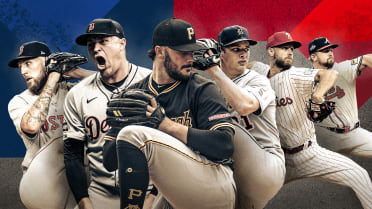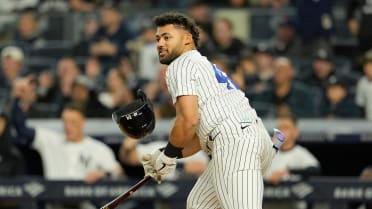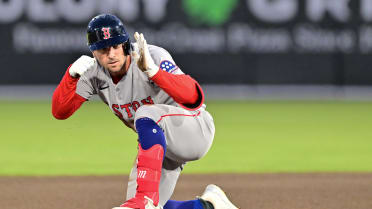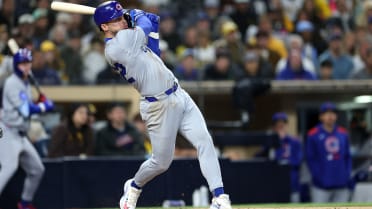Last year’s sprint wasn’t kind to anyone who got off-kilter with the start-and-stop offseason, or busted slowly out of the gates when play began. It wasn't kind to evaluators, either, who are trying to piece together a myriad of narratives, injury returns and small sample sizes to guess who will thrive in 2021.
But someone has to take a shot. MLB.com brought together five of its reporters to draft 10 established pitchers (five from each league) who are most likely to shake off 2020 and bounce back with the kind of seasons we came to expect.
Here are the selections:
AMERICAN LEAGUE
James Paxton-- LHP, Mariners
Key number: 28.9% strikeout rate in 2020
Yes, that James Paxton -- the lefty who’s had a tough history of staying on the field, to be generous. There’s hardly any part of Paxton’s left side that hasn’t caused him to miss time, and that continued in 2020, when he returned from back surgery only to see elbow issues limit him to five starts and a 6.64 ERA.
Here’s the thing, though: Paxton wasn’t good last year, but he also wasn’t 6.64 ERA bad. The Big Maple maintained similar strikeout and walk rates from his better years, even with a diminished left arm, explaining his much more respectable 4.12 Statcast expected ERA (based on quality of contact, punchouts and free passes). Last year’s lack of juice on his fastball is a concern, but then he was reportedly hitting 94 mph at his open bullpen session in November, apparently making Jerry Dipoto’s staff think that Paxton had priced himself out of the Mariners’ market (lefty Matthew Boyd, Paxton’s workout buddy, was effusive about how much Paxton’s ball was popping).
Call me an optimist, but I think Seattle got a bargain. Paxton might hit the injury list at some point, but I believe he’ll pitch well enough to make that worth it. The Mariners’ commitment to a six-man rotation can help, too.
--Matt Kelly
Shohei Ohtani -- RHP, Angels
Key number: 101.1 mph max velo, 7 pitches thrown 100+ mph in 2018
Ohtani probably could have easily made our list of bounceback hitter candidates too. A bounceback pitching season for him is a lot bigger question mark, but his future as a two-way player depends on it. Ohtani can still be a star on the mound, but we're taking a big bet on his arm health here. Ohtani the pitcher depends on two things: his velocity, and his splitter. He had neither in his brief return to the mound from Tommy John surgery last year. But check out what he's doing at the start of Spring Training …
If Ohtani can rebuild his arm strength, this is a 26-year-old ace who throws 100 mph with an unhittable splitter. Remember that Ohtani threw the fastest pitch of any starter in the entire 2018 season, and was the only starter to hit 101 mph multiple times. Remember that hitters batted .036 against Ohtani's splitter -- 2-for-55 with 35 strikeouts -- and whiffed on well over half their swings against it. Now, there's a big difference between that 2018 Ohtani and the 2020 Ohtani who was sitting in the low 90s and couldn't command his splitter at all. But that old ace-level Ohtani is still in there somewhere. Here's a bold prediction: Ohtani is healthy enough and good enough that he starts a game for the Angels in the playoffs this year.
--David Adler
John Means -- LHP, Orioles
Key number: 3.09 expected ERA in 2020
Means, Baltimore’s 11th-round pick in the 2014 Draft, was never a hyped prospect, but he emerged in 2019 as an All-Star and AL Rookie of the Year runner-up by posting a 3.60 ERA over 155 innings. Last season would appear to have been a step back for the 27-year-old, though. His ERA (4.53) rose by nearly a run and yet was still more than a run below his FIP (5.60). He got hammered for 12 home runs in just 43 2/3 innings. So is this a case of an out-of-nowhere player coming back to Earth after some initial success? A fluke?
Not so fast. Our own Mike Petriello already laid out a detailed case for this last month, but we’ll summarize. No pitcher last season had worse luck in terms of allowing more homers than would be expected based on his batted balls, one reason why his actual ERA was so much higher than his xERA (which was tied with Gerrit Cole and just slightly behind Lucas Giolito). For good measure, Means increased his fastball velocity by about 2 mph and raised his strikeout rate by about 5 percentage points while also lowering his walk rate. After posting an 8.10 ERA through six starts in the shortened season, Means was brilliant over his final four outings (1.52 ERA, 30-to-3 K-to-BB ratio in 23 2/3 innings). Now he’ll look to carry that into 2021.
--Andrew Simon
Frankie Montas -- RHP, Athletics
Key number: .225 expected wOBA allowed on four-seam fastballs in 2020
We saw Montas at his best in 2019, when he recorded a 2.63 ERA with a 20.3 K-BB% and a 96th-percentile barrel rate (3.8%). However, an 80-game suspension for violating MLB’s Joint Drug Prevention and Treatment Program put a damper on his breakout. The right-hander wasn’t able to replicate his success in 2020, as a strong start gave way to a rocky finish. Montas recorded a 5.60 ERA with a 15.6 K-BB% and a 7.8% barrel rate on the year, allowing four earned runs or more in five of his final seven outings.
On a positive note, Montas flashed an improved four-seam fastball last season, increasing his whiff rate to 33.3% (21.9% in 2019) and allowing a .225 xwOBA on the pitch -- the fifth-lowest mark among starting pitchers (min. 50 plate appearances ending on four-seamers). If that continues, it could allow the hard-throwing righty to decrease his reliance on his two-seamer/sinker, which has been his most oft-used pitch during his career despite yielding a .385 xwOBA.
--Thomas Harrigan
Zack Greinke -- RHP, Astros
Key number: Career-best 7.4 strikeout-to-walk ratio in 2020
With Gerrit Cole departing for the Bronx and Justin Verlander missing the entire season after undergoing Tommy John surgery, Greinke found himself needing to be the Astros' lone ace in 2020. Though he initially ran with the increased responsibility, posting a 1.84 ERA in his first five starts, Greinke ultimately stumbled to a 4.03 ERA, his second highest in any season over the last decade (4.37 in ‘16). He allowed at least three earned runs in each of his final seven starts -- his longest such streak since 2005, his first full season in the Majors. All that said, let's not write off the 37-year-old six-time All-Star just yet.
There was still plenty to like about Greinke’s shortened 2020 campaign. The 2009 American League Cy Young Award winner posted a 7.4 strikeout-to-walk ratio in ‘20, setting a career best for a second straight season (6.2 in ‘19). He had never finished with a strikeout-to-walk ratio better than 5.0 prior to '19. Those numbers were helped by a career-low walk rate of 3.3% in ‘20. Greinke also posted a 2.80 FIP last season, his best since putting up a 2.76 FIP in '15, when he finished with a ridiculous 1.66 ERA. The 1.23 disparity between Greinke's 4.03 ERA and 2.80 FIP was easily the largest for any pitcher in the Majors (Matthew Boyd was second with a 0.94 difference).
So why did Greinke’s numbers suffer? Frankly, some of it was just bad luck. Opponents had a .321 BABIP against Greinke last season, second-highest in the American League -- and Greinke's highest since 2005. Now, sure, Greinke allowed a few more barrels than usual (8.2 opponents' barrel rate in '20, compared to 6.2 in '19), but his opponents' average exit velocity overall was 86.8 mph -- his lowest since Statcast started tracking in '15. All things considered, Greinke's xWOBA of .286 was actually two points lower than it was in '19. In fact, it was his lowest xWOBA in the last four seasons, yet his actual wOBA of .289 was his highest during that same span. Those are the types of things that could balance out over the course of a full season, and with his elite strikeout-to-walk ratio only getting better, Greinke is primed for a bounceback season in '21.
--Paul Casella
NATIONAL LEAGUE
Jack Flaherty -- RHP, Cardinals
Key number: 34.5% whiff rate in 2020
It's easy to write off any struggling player's numbers from last year given the unusual circumstances surrounding the shortened season, but that's perhaps most true for Flaherty. The budding 25-year-old Cardinals ace was coming off back-to-back impressive seasons, only to put up a 4.91 ERA in nine starts in 2020. On the surface, an ERA near five over 40 1/3 innings might seem worrisome, but let's take a closer look at Flaherty's season.
After an impressive Opening Day start (two runs over seven innings), Flaherty went nearly four weeks before his next outing due to the club's COVID-19 outbreak. Even once the Cards resumed play, Flaherty didn't break the 90-pitch mark until Sept. 10, as St. Louis had to slowly ramp their pitchers back up. Keep in mind, this is a guy who averaged 96 pitches per start in 2019, when he posted a 2.75 ERA en route to finishing fourth in NL Cy Young Award voting.
Making that 4.91 ERA even less concerning is the fact that nearly all of that damage came in a disastrous Sept. 15 outing against the Brewers in which Flaherty was tagged for nine runs in just three innings. That outing aside, Flaherty had a 3.13 ERA in his other eight starts. Not to mention, his best outing of the year -- six innings, two hits, one run, 11 strikeouts -- came in the start directly after that Milwaukee meltdown. If you needed more convincing, Flaherty's strikeout numbers in 2020 (10.9 strikeouts per nine innings, 34.5% whiff rate) were right on par with the elite numbers he put up in '18 (10.9 K/9, 31.6% whiff rate) and '19 (10.6 K/9, 30.9% whiff rate). Expect Flaherty to be just fine in '21, starting with his Opening Day assignment against the Reds.
--Paul Casella
Charlie Morton -- RHP, Braves
Key number: 3.89 expected ERA in 2020
After finishing third in the AL Cy Young Award voting in 2019, Morton posted a 4.74 ERA last season -- his age-36 campaign. Is this the end of the line for the veteran righty? The Braves certainly don’t think so, as they gave Morton $15 million on a one-year deal in November.
I tend to agree, especially because Morton’s ERA was skewed by the six earned runs he surrendered in his first start of the year. In his final eight starts of the regular season, Morton had a 3.71 ERA, and his .293 xwOBA allowed on the year was nearly identical to the .289 xwOBA he recorded from 2017-19.
Furthermore, Morton encouragingly showed increased velocity after returning from right shoulder inflammation in September. In four outings before going on the injured list, he averaged 92.7 mph with his four-seam fastball. In eight starts after returning (postseason included), his four-seamer sat at 94.4 mph. With a normal spring to build up his arm, Morton could come out firing in 2021.
--Thomas Harrigan
Chris Paddack -- RHP, Padres
Key number: .204 BA allowed on fastballs in 2019
As a rookie in 2019, Paddack backed up his swagger with results, posting a 3.33 ERA over 26 starts, despite his limited repertoire. (He threw about 90% four-seamers and changeups, with an occasional curveball that didn’t miss many bats). Paddack tried to diversify in ‘20, introducing a cutter, but the pitch was unsuccessful. At the same time, his four-seamer suffered, losing its vertical movement (“rise”) as Paddack was unable to command it at the top of the zone with the same efficiency. In 2019, opponents hit .204 and slugged .391 against the four-seamer; in ‘20, that rose to .308/.658, with a 3.4 mph jump in average exit velocity.
In the span of a year, Paddack has gone from the Padres’ Opening Day starter to something of an afterthought behind three new acquisitions (Yu Darvish, Blake Snell, Joe Musgrove), a 2020 Cy Young contender (Dinelson Lamet) and even rising top prospects such as Mackenzie Gore. But there’s still a lot to like about the ultra-competitive Paddack, who even last year boasted one of the lowest walk rates in MLB. If the 25-year-old finally finds that third pitch, the results could be spectacular, but even just rediscovering his four-seamer command would work wonders.
--Andrew Simon
Stephen Strasburg -- RHP, Nationals
Key number: 2.51 ERA over last 22 games of 2019 (reg. + postseason)
Hopefully the 15 minutes it took to fix up Strasburg's carpal tunnel is also all it takes to get him back to his old self. Why wouldn't it? Strasburg was trying to pitch with a numb hand in 2020 … and it sure seems like a numb hand would make it hard to pitch. And now he's better. So we'll throw out Strasburg's lost season (two games, five innings pitched) and bet on him looking a lot more like the guy who was the 2019 World Series MVP.
Last time he was healthy, Strasburg was one of the best pitchers in baseball. From July 2019 through the end of the postseason, he had a 2.51 ERA and 174 strikeouts in 136 1/3 innings. Only Jacob deGrom, Jack Flaherty, Gerrit Cole, Sonny Gray and Mike Clevinger had a better ERA in that time (and none did it over as many games as Strasburg). Only Cole and Verlander had more strikeouts. Stras will be Stras again in 2021.
--David Adler
Mike Soroka -- RHP, Braves
Key number: 5% barrel-per-batted ball rate since MLB debut
The projections expect Soroka to regress, a fair notion for a ground-ball pitcher coming back from a torn Achilles tendon. But I’m remembering one of the most polished young all-around arms in recent times and betting that, similar to worm-burner Dallas Keuchel, Soroka will surpass expectations on a near perennial basis.
We didn’t feature Soroka in our recent look at MLB’s deepest arsenals, but he would have qualified had he not missed most of 2020 thanks to his three plus pitches: the changeup, slider and sinker. Soroka makes up for lack of velocity with impressive command and poise, which helped him avoid two pitcher-killers back in ‘19: walks and barrels. Soroka already knows how to not beat himself. I think he’ll only keep improving.
--Matt Kelly
Matt Kelly is a reporter for MLB.com based in New York.
David Adler is a reporter for MLB.com based in New York.
Andrew Simon is an editor and writer for MLB.com.
Thomas Harrigan is a reporter for MLB.com.
Paul Casella is a reporter/editor for MLB.com based in Philadelphia.




